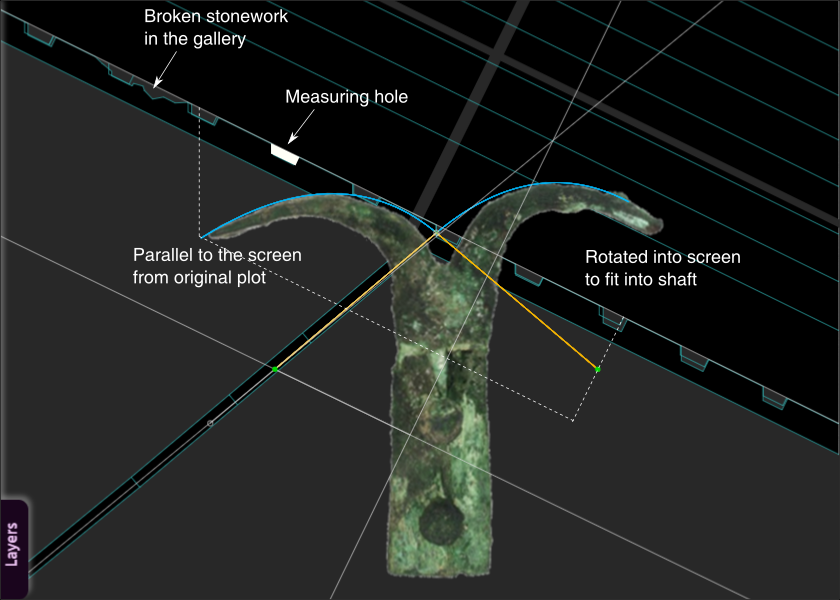
After a lengthy diversion to calibrate the building's geometry and correct the surveying of the pyramid we can now return to where we left off at the end of the intermediate section of this work. The final piece of geometric architecture that was identified in that section was the key to the pyramid's architecture and the interactive drawing shows a snapshot of the key plot from the last page of the intermediate section of this work.
On the image you can see the two arms of the key labeled. The right side is the arm that is formed from rotating the original plot into the shaft by 40°, which is the surveyed approximate angle of the shaft. However the angle of this shaft cannot be measured either in the geometry, or in the pyramid itself using robotic sensors, and so this side of the key can be discarded as it is based on approximate measurements.
On the left side is the original plot which has been rotated by 180° and then reflected in a vertical axis and so it is parallel to the plane of the screen and needs to be retained because its formation geometry is precise.
The two ends of the part of the plot that is being retained are shown with dotted white lines, that on the left is vertical and aligns with the broken section of gallery floor, and that on the right is perpendicular to the gallery floor.
The floor of the gallery is raised on each side with what have been called "benches", and cut into these side benches are a series of regularly placed measuring holes which can be seen on the drawing. If you look at the measuring hole that is highlighted in the gallery you can see that the dotted lines that define the geometric plot are of exactly the same format as the cut hole. The dynamic plot needs to be projected onto the gallery floor using this hole as the guide to the projection.
Click here to remove the key from the shaft and start the clock on the drawing which will then plot just the left side of the key, along with its vertical and perpendicular projections onto the gallery floor as defined by the measuring hole.
This fascinating dynamic geometry shows the retained part of the key plot being projected onto the benches which are on either side of the gallery floor - allow it time to draw out the plot clearly.
If you now pause the clock when the plot is at its right most extreme you can see how the gallery floor's measuring holes relate to the dynamic geometry.
The measuring hole in the gallery is aligned with the projection geometry and if you look in particular at the vertical projection point it is aligned perfectly with the left edge of the measuring hole. If you look at the mid point of the projection line, where the blue and yellow lines meet, you can see that this also falls perfectly onto the left edge of one of the measuring holes.
The yellow part of the vertical projection is therefore moving up and down the gallery for a distance of exactly two measuring holes and this is particularly significant because the format of the measuring holes has already been worked out by the archaeologists, and it is geometric in nature. If you zoom in closer to the measuring holes, the overlaid graphic shows how these measuring holes have been created.
The holes alternate between long and short, with the short holes measuring 1 cubit along the slope of the gallery and the long holes measuring 1 cubit horizontally. The gaps between the holes are consistently 2 cubits in horizontal length, and so it is possible to work out the length along the slope between the same point on holes spaced two apart, as is the case with the vertical projection dynamic plot. The distance along the slope of the gallery benches is 1 + 5/Cos(a) where a is the angle of the gallery floor, which is known with precision as being -26.280999.
The length of the vertical projection plot line on the slope of the gallery bench must therefore be 6.576415 cubits and its length must be highly significant because the architects have made the calculation components explicit.